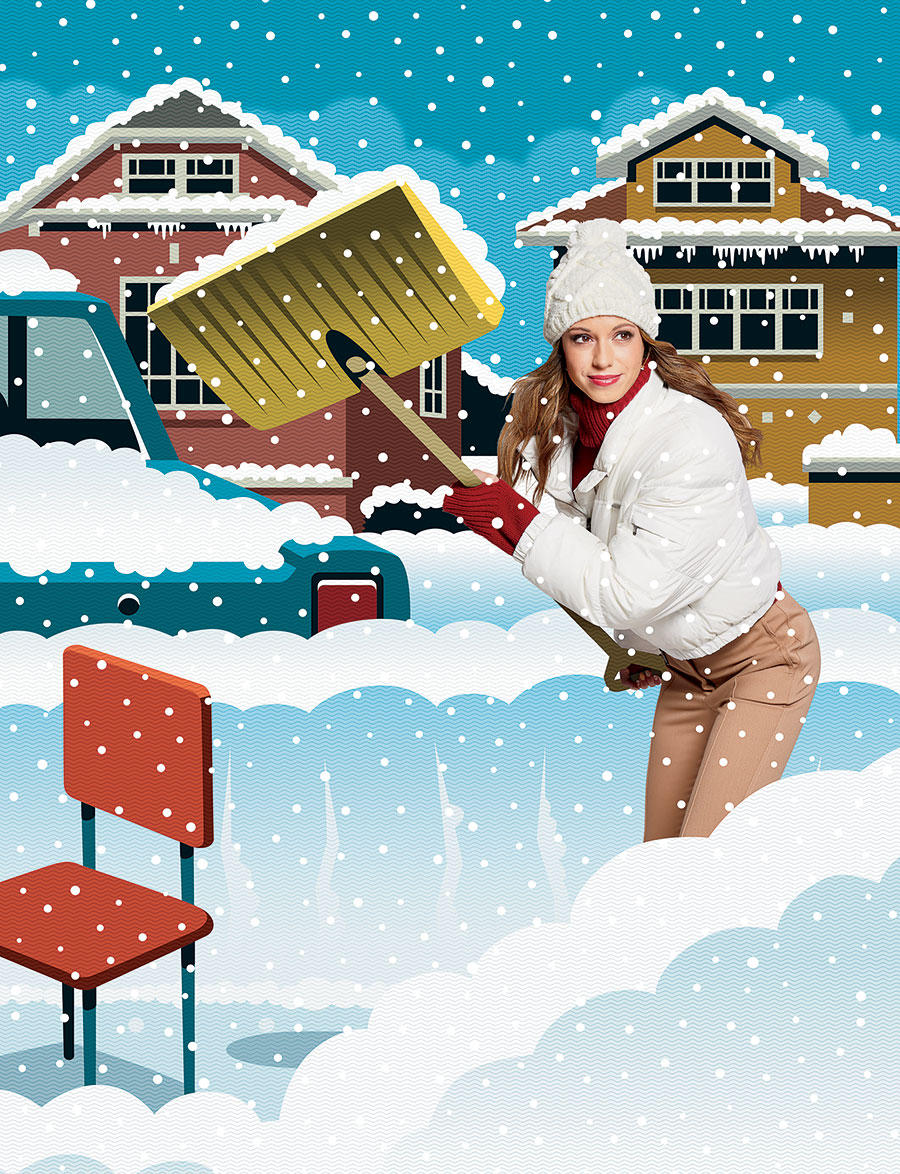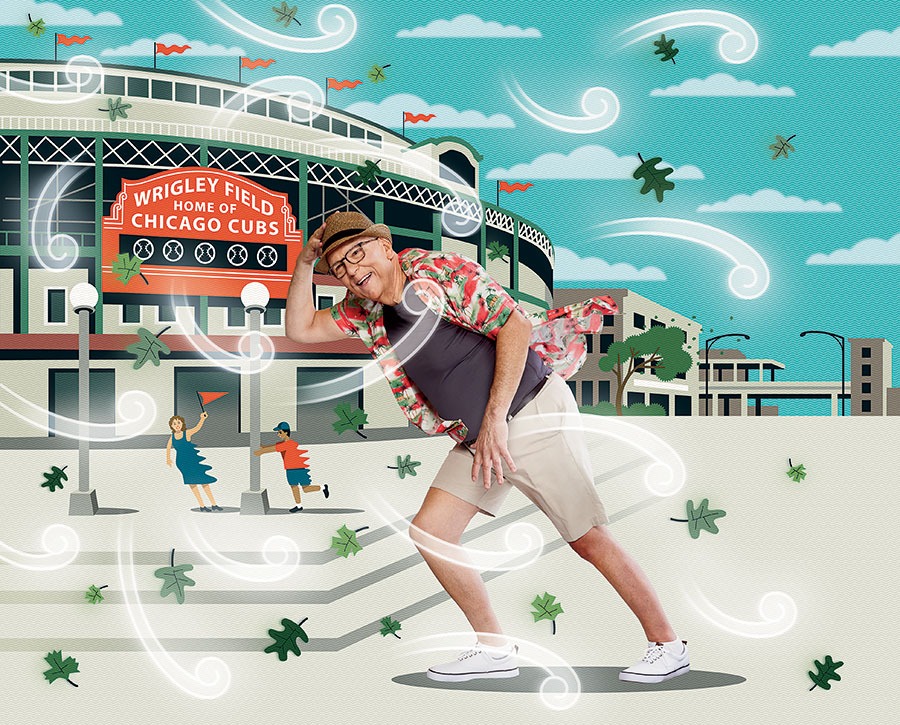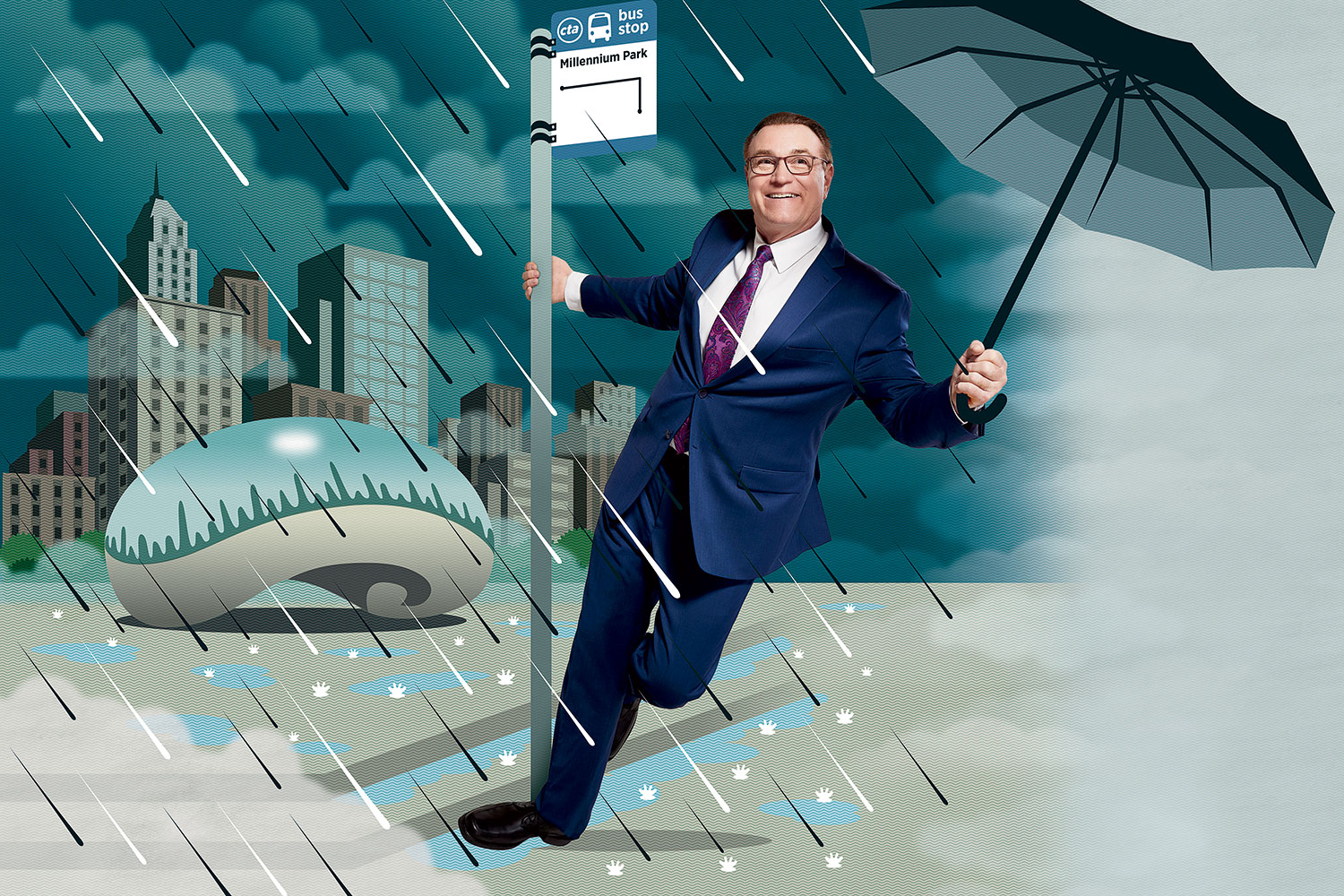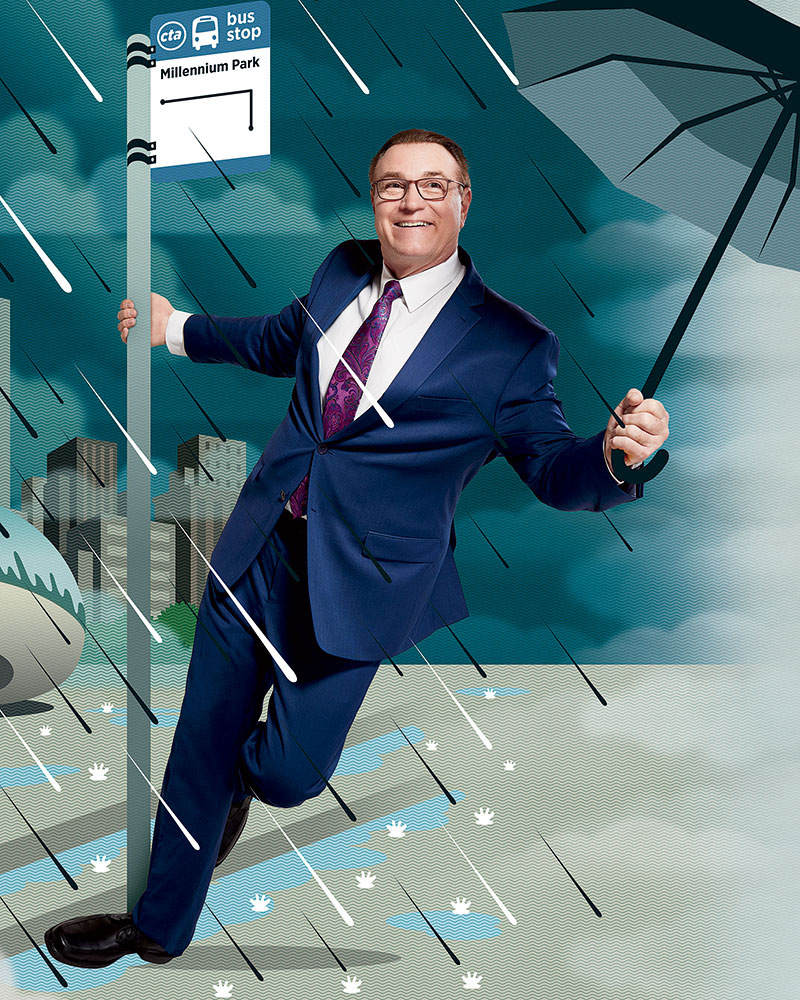I.
“Broadway for weathermen”
Skilling:We’re in a very volatile weather regime around Chicago. [Former Chicago meteorologist and Weather Channel cofounder] John Coleman used to call it Broadway for weathermen, and it really is true. If you want a variety of weather to forecast, it does make the job awfully interesting. We’re in a midlatitude atmospheric clash zone where weather tends to change rather precipitously and rapidly. We have the retreating cold of winter fighting with the building warmth of spring and summer. Then, on top of that, we have this little thing called Lake Michigan sitting next to us.
Miller:Materials have something called specific heat — how they retain heat and how they lose heat. An aluminum pan has a low specific heat. If you’ve got Tater Tots in the oven, you can pull them out and grab the aluminum and you won’t burn your hands, because it dissipates heat quickly. Water has an interesting property: It hangs on to energy for a long period of time. So once a body of water like Lake Michigan cools, it stays cool and takes a while to warm up. In the fall, that keeps the climate milder near the lakefront.
Scott:Wind is driven by pressure differences in the atmosphere and starts with the sun, which heats the atmosphere. Moving down a frictionless lake, it gains all of this momentum. And Chicago has these tall buildings, so when we get cold wind off Lake Michigan — which controls almost a third of our weather — the buildings and streets act almost like canyons that help funnel it and make it go even faster. But we’re not the windiest city in terms of wind speed. There’s some data looking at the top 10, and Chicago isn’t even on the list.
II.
“I now understand why frostbite can occur within minutes”
Skilling:I remember there was a blizzard advisory out two days ahead of the Groundhog Day blizzard of 2011. It was incredibly well predicted. Louis Uccellini, who is a friend of mine and became head of the National Weather Service, emailed me a picture of all these cars stuck in snowdrifts on Lake Shore Drive. And he put this line: “What part of ‘blizzard warning’ didn’t these folks understand?” Of course, there were extenuating circumstances. I talked to one woman who was stuck in her car and said, “Look, I knew the storm was coming, but I hadn’t expected that a CTA bus would jackknife and block traffic.” Oh my word, we had 70-mile-an-hour winds. We call them geostrophic winds. That means they come off the lake friction-free. That blizzard introduced a level of wind along the lakeshore that was extraordinary.
Scott:I’ll never forget the polar vortex of 2019. The temperatures dropped to 23 below zero the morning of January 30, and wind chills ranged from 45 to 56 below. Historic cold. It’s definitely the coldest weather I’ve ever witnessed. The city basically shut down to keep everyone as safe as possible. I hadn’t seen that before due to cold weather. That morning, I drove to the lakefront and did what I probably shouldn’t have done: I got out of the car. You could feel the cold the second you stepped outside. I now understand why frostbite can occur within minutes. It was like pins and needles all over. You could barely breathe. It was remarkable to see the steam coming off Lake Michigan — it was otherworldly, like a scene out of a sci-fi film. I wanted to take a video so I could remember this, and my phone just shut off. It was too cold for it to function.
Skilling:During the Korean conflict, the U.S. military discovered that our soldiers were suffering frostbite in temperatures that didn’t appear to be cold enough to produce it. That’s when the military started taking seriously this notion that you actually get an enhanced cooling effect when wind is blowing. Therefore, there needed to be some way to quantify that. Far from just hyping the situation, the wind chill temperature is an attempt to quantify the combined effect of wind and temperature, which can evaporatively cool human flesh to below the air temperature.
Miller:They changed the wind chill formula. In the old days, we used to have wind chills of 70-something below zero, but they were measured with a tin can or some bizarre thing. Since they reevaluated it, you don’t see those scary numbers.
Scott:I’ve seen meteorologists who wear wetsuits to help them stay dry longer when they’re reporting in cold weather. I’ll wear at least three to four layers of clothing and make sure I’m in waterproof outerwear. I keep hand warmers and foot warmers with me, too. I’ve also invested in some winter gear, including a heated vest by Venture Heat and heated gloves by Hestra. These are game-changers if you’re going to be outdoors for a prolonged period of time. And I always splurge on one really nice winter coat that can last for years. Make sure it’s heavy, down, and goes below the knees. I have a Burberry coat that I live in during the winter.

III.
“Of all the extreme weather events, heat waves are among the most deadly”
Skilling:Before July of 1995, when more than 700 Chicago-area residents perished in a heat wave, we viewed heat as an inconvenience. When we would talk about extreme heat, people in the weather profession would say, “Oh, get over it. It’s summer and it gets warm.” But we discovered, in spades, that heat can kill. In fact, we know today that of all the extreme weather events, heat waves are among the most deadly. And they’re insidious. After the third night of triple-digit daytime heat indices, people started dying in increased numbers. If you couple heat with humidity, you shut down the body’s ability to cool itself by what’s called evaporative cooling.
Miller:I was working the weekend the heat wave started. We wound up with a big bubble of hot air that just sat on us. People in brick bungalows without air conditioning who had never experienced heat like this before tried to ride it out with just a fan. They didn’t turn on their air conditioning because they were afraid of what the bill was going to be or were in neighborhoods where they were afraid to open their windows. It really was an urban disaster.
Skilling:When city officials then started combing through mortality stats to look at previous heat waves, buried in those stats was that people’s deaths had been listed as the result of a respiratory issue or a cardiovascular issue rather than heat. Because of what happened in Chicago, the modeling of these extreme heat events is so much better today.
Scott:You want to think about having fans around the house, taking cold showers, dressing in light layers, and drawing your blinds so the sun isn’t beating in.
Skilling:The most important thing to realize is that the most vulnerable among us are the elderly and the infirm. If your neighbor is elderly, knock on their door and make sure they’re OK and have some ventilation going. If not, the city now provides transportation to cooling centers.
IV.
“Tornadoes can hit anywhere”
Scott:It’s a misconception that tornadoes can’t hit cities like Chicago. A lot of people think that the lake and buildings protect us. That’s not true. Tornadoes can hit anywhere. We’ve had confirmed tornadoes touch down within city limits. We had an EF1 [on the weaker end of a scale of 0 to 5] hit Rogers Park in August 2020.
Skilling:It had been so long since we’d had a big tornado outbreak like the 1967 Oak Lawn–Belvidere tornadoes, so the Plainfield tornado [in 1990] was a wake-up call. All that afternoon, I’d been watching these cumulus clouds blowing up on the satellite, and we knew the atmosphere was primed to explode. We just didn’t know how badly, or precisely where. I was watching this level 5 top-intensity supercell crashing southward through DeKalb County and into Kane County and thought, My God. This was pre-internet: We didn’t have instant feedback on social media. All I could think was, I wonder what’s happening to people under that. About 3:40 in the afternoon, the phone rang. It was my colleague Jim Ramsey, who said that WBBM radio was reporting that Plainfield High School had been destroyed. My worst fears had been realized. It was a particularly insidious tornado because it was what we call rain wrapped. Had you been on the ground watching that storm come in, all you would’ve seen was a dark cloud that appeared to reach to the ground. You wouldn’t have realized that enveloped within this rain was a terrible tornado. As a profession, we felt horrible that we hadn’t better handled that situation. After that, there was a major effort to upgrade our forecasting system, and the National Weather Service accelerated the installation of Romeoville’s Doppler radar.
Miller:I’m a pilot, and a week after the Rochelle-Fairdale tornado in 2015, I flew out over the area. It’s a little tiny community. This tornado came through and ripped it. It was just in the wrong place. That’s the stuff that haunts you. You can see on the radar where someone is having perhaps the worst day of their lives.
Scott:On June 20, 2021, a tornado touched down in Naperville and Woodridge, just 20 or so miles outside the city. It was an EF3, with winds up to 140 miles per hour. We had a severe threat that afternoon and early evening, but nothing really came to fruition, so we thought we were out of the woods. As we went into late night, the storm system erupted and we started to get these tornado warnings. At around 10:30, we went on-air. It was my first time covering tornadoes on live TV. On our radar, we could see debris from the tornado being lofted to nearly 20,000 feet. At that moment, you realize the severity of the situation. You know that lives are at stake and that people are potentially losing their homes or belongings, and that’s a lot to take in and think about when you’re trying to deliver this news to viewers.
Skilling:What’s so devastating about a tornado is the debris that it blows through the air. What you essentially have is a wall of airborne projectiles — shards of glass, metal, wood — all ready to spear you. In high-rises, go into a hallway at the center of the building and stay away from windows. Of all the safety rules regarding tornadoes, that should be front and center. God forbid, you could be sucked out a window. If you can get to the basement, go to the center of it. We used to tell people to go to the corners, but the winds of a tornado are rotary and so they tend to pile debris in the corners. Most high-rises are not going to collapse, but if the building comes down, you want to be under something, like a workbench, that can protect you.

V.
“If you’re struck by lightning, it’s a life-altering event”
Miller:Lightning is the most chilling hazard out there. I was at a weather conference 10 or 12 years ago, and they had a gentleman who was pushing lightning safety. He had been on a golf course, on the green with a putter in his hand, when a lightning strike hit nearby. It jumped over to the gold chain on his neck, rode down the perspiration on his arm to his putter, and went to the ground. His companions weren’t injured, but he was messed up. He went through several surgeries. His speech was slurred. And he was explaining to us that there literally is no safe place outside when there’s lightning. That’s the message I keep pounding: Get inside your car or a building.
Skilling:If you’re struck by lightning, it’s a life-altering event. Dr. Mary Ann Cooper, with whom I worked for many years, is a physician who studied lightning-strike injuries. She said it’s like sending an electrical surge through your computer. You have phantom pain in the years that follow, you’re more subject to depression, and you can be burned terribly. Lightning turns your perspiration to steam, which produces burns. She said you’re not going to be fried like a crispy critter but you’re going to be affected in ways that are unimaginable.
Miller:I did a story years ago about this baseball diamond in the near west suburbs. They were worried about lightning, so they installed this Thor Guard system. When it detects a surface charge approaching — there’s an induced charge that rolls along the earth underneath a thunderstorm — it sets off a warning horn. On the day of the field dedication, the horn went off, everybody took shelter, and a lightning strike hit the diamond. Can you have any more evidence than that?
Skilling:There was thunder and lightning during the Groundhog Day blizzard. They’ve done studies on the lightning that occurs in snowstorms. It’s what’s called positively charged lightning. It’s higher amperage and more dangerous than your average run-of-the-mill lightning, which is dangerous enough.
VI.
“Everything has become more active because the atmosphere is warmer”
Scott:Climate change is impacting us. We’re seeing our average temperatures go up, especially our winter morning temperatures, which have increased over the past decade. The frequency of heavy rain and thunderstorm events has also increased over the past 10 to 20 years. When we get a lot of wet weather over a period of time, we put more heat into the atmosphere, which fuels more rain and storms.
Miller:Everything has become more active because the atmosphere is warmer. Twenty years ago, if there was a thunderstorm that popped up in the afternoon, it could be just a summertime thunderstorm. Now it could be a severe thunderstorm. I know a guy at the Storm Prediction Center in Norman, Oklahoma, who went back a hundred years through all of the records we have of humidity in the atmosphere and graphed them on his laptop. He ran an image of North America that showed the red blob of moisture in the atmosphere coming up from the Gulf of Mexico during the spring and summer and then retreating during the winter. Over the years, this moisture came up to the lower latitudes, and then, suddenly, it was going north of Chicago.
Skilling:We’ve always had ups and downs in lake level, but they’re occurring with greater frequency. The lake was at record high levels in 1986, at record low levels in the early 2000s, and then it went back to record high levels again in 2019 and 2020. Now we’re watching the levels come down again. These have dramatic impacts on our shoreline. There are pictures of homes built along the Wisconsin shoreline a hundred years ago that are now going into the water.
VII.
“A unique relationship with our viewers”
Scott:If you get a message on your phone about a tornado warning, the app is not going to tell you where that tornado exactly is. It’s not going to tell you how fast it’s traveling. It’s not going to tell you the cities that it’s about to impact. Especially during severe weather, you still need that scientist, that meteorologist, assessing the data, interpreting it, forecasting it for the public so they can understand what they can expect and where.
Skilling:I’ve always felt the weatherperson, of all the on-air folks, has a unique relationship with our viewers, and I think it’s because of the universal nature of weather’s impact on people. With extreme weather, some people will say, “Oh, you’re hyping it.” I do think we’ve got to be careful. I have this discussion with producers quite a bit when we lead the news with weather. I think the best we can do is flag a situation: “Look, we’re not perfect at forecasting this, but this is a period to watch for possible extremes of heat or thunderstorms or rain or cold.” If you’re honest with your viewers, people respond to that.




